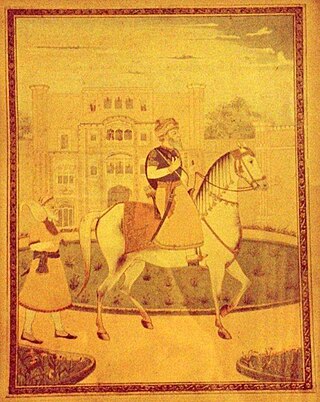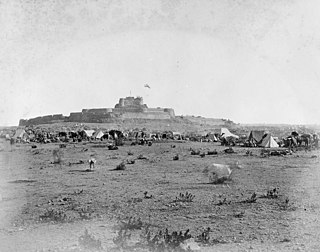
The Sikh Empire was a regional power based in the Punjab region of the Indian subcontinent. It existed from 1799, when Maharaja Ranjit Singh captured Lahore, to 1849, when it was defeated and conquered by the British East India Company in the Second Anglo-Sikh War. It was forged on the foundations of the Khalsa from a collection of autonomous misls. At its peak in the 19th century, the empire extended from Gilgit and Tibet in the north to the deserts of Sindh in the south and from the Khyber Pass in the west to the Sutlej in the east as far as Oudh. It was divided into four provinces: Lahore, which became the Sikh capital; Multan; Peshawar; and Kashmir from 1799 to 1849. Religiously diverse, with an estimated population of 4.5 million in 1831, it was the last major region of the Indian subcontinent to be annexed by the British Empire.

Hari Singh Nalwa was Commander-in-chief of the Sikh Khalsa Fauj, the army of the Sikh Empire. He is known for his role in the conquests of Kasur, Sialkot, Attock, Multan, Kashmir, Peshawar and Jamrud. Hari Singh Nalwa was responsible for expanding the frontier of Sikh Empire to beyond the Indus River right up to the mouth of the Khyber Pass. At the time of his death, the western boundary of the Empire was Jamrud.

Maharaja Gulab Singh Jamwal (1792–1857) was the founder of Dogra dynasty and the first Maharaja of the princely state of Jammu and Kashmir, which was a part of Panjab and Sikh Empire became the largest princely state under the British Raj, which was created after the defeat of the Sikh Empire in the First Anglo-Sikh War. During the war, Gulab Singh would later side with the British and end up becoming the Prime Minister of Sikh Empire. The Treaty of Amritsar (1846) formalised the transfer of all the lands in Kashmir that were ceded to them by the Sikhs by the Treaty of Lahore.

Sultan-ul-Qaum Sardar Jassa Singh Ahluwalia was a Sikh leader during the period of the Sikh Confederacy, being the Supreme Leader of the Dal Khalsa. He was also Misldar of the Ahluwalia Misl. This period was an interlude, lasting roughly from the time of the death of Banda Bahadur in 1716 to the founding of the Sikh Empire in 1801. He founded the Kapurthala State in 1772.
Alawalpur is a town and a municipal council in Jalandhar district in the state of Punjab, India. Alawalpur is named after Alawal Khan, a Pathan who ruled the area during the time of Maharajah Ranjit Singh. Sardar Himmat Singh Jallewalia a Bains Jat Sardar, a general in Ranjit Singh's army, later conquered Alawalpur. His descendants still live in a fort located at the center of the city.

The Battle of Jamrud was fought between the Emirate of Afghanistan under Emir Dost Mohammad Khan and the Sikh Empire under Maharaja Ranjit Singh on 30 April 1837. Afghan forces confronted the Sikh forces at Jamrud. The garrisoned army was able to hold off the Afghans till Sikh reinforcements arrived to relieve them.

The Jamrud Fort is located beside Bab-e-Khyber at the entrance to the Khyber Pass from the Peshawar side in the tribal district of Khyber KPK, Pakistan. After death of Sardar General Hari Singh Nalwa, Khalsa Sarkar Wazir Jawahar Singh nominated Sardar General Gurmukh Singh Lamba as chief administrative and military commander to restore and consolidate the Khalsa army gains. General Sardar Gurmukh Singh Lamba was nominated as chief administrative and military commander to consolidate the gains of Khalsa Sarkar.

Diwan Mokham Chand was one of the chief commanders of the Sikh Empire. He conquered Attock from the Durrani Afghans in 1813 and subdued the Rajputs in the Hills of Himachal and in Jammu at Jasrota, Chamba, and Basroli. He also commanded one of the early Sikh expeditions to conquer Kashmir that ended in failure due to bad weather blocking the passes to the valley. Mokham Chand was born in a Hindu Khatri family origin.

The Battle of Nowshera was fought in Nowshera in March 1823 between the Yusufzai Afghans, supported by the Peshawar sardars, alongside Azim Khan Barakzai, the Afghan governor of Peshawar, where they would face the Sikh armies led by Maharaja Ranjit Singh. Azim Khan was a half-brother of Dost Mohammad Khan, future ruler of Kabul, and later Afghanistan. The battle was a victory for the Sikhs, successfully defeating Azim Khan's armies. This victory allowed them to begin to their occupation of the Peshawar Valley.

The Battle of Attock took place on 13 July 1813 between the Sikh Empire and the Durrani Empire. The battle was the first significant Sikh victory over the Durranis.

Akali Phula Singh Nihang was an Akali Nihang Sikh leader. He was a saint soldier of the Khalsa Shaheedan Misl and head of the Budha Dal in the early 19th century. He was also a senior general in the Sikh Khalsa Army and commander of the irregular Nihang of the army. He played a role in uniting Sikh misls in Amritsar. He was not afraid of the British who at many times ordered for his arrest but were not successful. During his later years he served for the Sikh Empire as a direct adviser to Maharaja Ranjit Singh. He remained an army general in many famous Sikh battles up until his martyrdom in the battle of Nowshera. He was admired by the local people and had a great influence over the land and his settlement was always open to help the poor and helpless. He was well known and was a humble unique leader and prestigious warrior with high character. He was also known for his effort to maintain the values of Gurmat and the Khalsa panth.
Amar Singh Majithia was a soldier and administrator during the Sikh Empire.

Ahluwalia was a misl, that is, a sovereign state in the Sikh Confederacy of Punjab region in present-day India and Pakistan. The misl's name is derived from Ahlu, the ancestral village of the misl leaders. The Ahluwalia misl was one of the 12 major Sikh misls, and held land to the north of Sutlej river.
The Battle of Mangal was fought between the Sikh forces led by Hari Singh Nalwa and the Jadoon, Tanaoli and Swati tribes led by Mahomed Khan, Bostan Khan and Najeebullah Swati.

The Standoff at the Khyber Pass (1834–1835) was a short conflict from May 1834 to May 1835 by the Sikh forces led by Maharaja Ranjit Singh and the Afghan forces led by Dost Mohammad Khan. The conflict began as the Sikh Empire expanded into Peshawar, deposing the Peshawar Sardars, while also supporting the deposed Durrani dynasty in their attempts to return to the throne of Afghanistan under Shah Shuja Durrani.
The Battle of Kashmir (1814) (also known as the 'third invasion of Ranjit Singh" to invade Kashmir. After the invasion of Attock, Ranjit Singh wanted to invade Kashmir, which led to the third campaign in Kashmir under Hari Singh Nalwa and Ram Dayal. During the third campaign of Ranjit Singh, Sardar Muhammad Azeem Khan defeated Ranjit Singh's forces, inflicting heavy casualties.
The Battle of AkoraKhattak was fought between the Sikh Empire and Mujahideen, mainly Afghans, under Syed Ahmad Barelvi. Local Yusufzai and Khattak Pashtuns, led by Khadi Khan, supported Sayyid, and the attack was successful, resulting in significant casualties for the opposition.
In 1820, Yousafzai once again revolted against the Sikh Empire, which led to the Battle of Gandgarh. Hazara was under Diwan Ram Singh with thousands of well-equipped soldiers; on the other hand, Yousafzai tribesmen were local zamindars. Yousafzai Afghans killed the governor of Hazara, Diwan Ram Daya.

The Military campaigns of Hari Singh Nalwa were a series of conquests and battles in which the Sikh Empire commander Hari Singh Nalwa fought from 1807 to 1837. His first battle was fought against the Durrani Empire. With his help, the Sikh Empire managed to expand over a large land area, spanning from Jamrud to Tibet. He was killed in the battle of Jamrud at Khyber Pass in 1837.

The siege of Mankera, also known as the fall of Mankera was fought from 7 December 1821 to 1 January 1822 by the Sikh forces led by Maharaja Ranjit Singh and the Mankera forces led by Nawab Hafiz Ahmad Khan.













